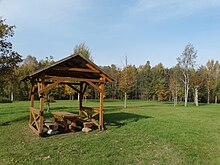Battle of Skuodas
| Battle of Skuodas | |||||||
|---|---|---|---|---|---|---|---|
| Part of the Lithuanian Crusade | |||||||
 Place of the battle of Skuodas, Luknės, Lithuania | |||||||
| |||||||
| Belligerents | |||||||
| Samogitians | Livonian Order, Curonians | ||||||
| Commanders and leaders | |||||||
| Alminas | Bernard von Haren[2] | ||||||
| Strength | |||||||
| 3,000 | Unknown | ||||||
| Casualties and losses | |||||||
| Unknown | 33 knights killed | ||||||
The Battle of Skuodas or Schoden[2] was a medieval battle fought in ca. 1259 near Skuodas in present-day Lithuania during the Lithuanian Crusade. The Samogitian army of 3,000 invaded Courland and on their way back defeated the Livonian Order, killing 33 knights and many more low-rank soldiers.[3] In terms of knights killed, it was the eighth largest defeat of the Livonian Order in the 13th century.[4] This victory led to a Semigallian insurrection against the Livonian crusaders, which lasted from 1259 to 1272.
Background
In 1251,
Battle
When the truce expired, Samogitians did not seek an extension, but once again organized a raid to Courland.[2] This raid might have been prompted by Mindaugas, who granted Samogitia in its entirety to the Order on 7 August 1259 while seeking allies against the Golden Horde that plundered Lithuanian lands in the winter of 1259.[3] However, the exact date or year of the battle is unknown. Historian Edvardas Gudavičius dated the battle late summer or early autumn 1258.[9]
While the Samogitians were plundering Courland, the knights from
Aftermath
The battle inspired the Semigallians to rebel against the Order. The Knights, finding little success in an open battlefield turned to strategic warfare. They attacked Tērvete (Terwerten) hoping to turn the Semigallian outpost into a Teutonic castle.[12] When the attack failed, they built a fortress in nearby Dobele (Doblen) and Goergenburg (possibly present-day Jurbarkas) in Samogitia.[13] Both castles were soon attacked by the Semigallians and Samogitians. The following year, the Samogitians raided Courland again and provoked the Knights into the Battle of Durbe, where the Order suffered even greater defeat. After these disasters, it took some thirty years for the Livonian Order to restore its status and territory.[14]
References
- ^ "Skuodo mūšis: sukanka 750 metų". Vakarų ekspresas (in Lithuanian). 2009-07-17.
- ^ a b c d Urban, William. The Baltic Crusade, pp. 245–246.
- ^ a b Baranauskas, Tomas (2006-08-19). "Chronology. High Middle Ages: Part 2 (1183–1283)". Medieval Lithuania. Archived from the original on 2010-06-15. Retrieved 2015-04-12.
- Delfi.lt. Retrieved 2007-06-02.
- ISSN 1392-0677.
- ISBN 9986-810-13-2.
- ISBN 0-929700-10-4.
- LCCN 79346776.
- ISBN 9986-34-020-9.
- ^ Gudavičius, Edvardas. Mindaugas, p. 268
- ^ Gudavičius, Edvardas. Mindaugas, pp. 270–273
- ^ Gudavičius, Edvardas. Mindaugas, p. 274
- ^ Gudavičius, Edvardas. Mindaugas, pp. 275–276
- ^ Urban, William. The Baltic Crusade, p. 248.
